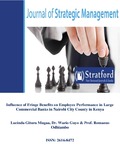| dc.identifier.citation | Mugaa, L., Guyo, D. W., & Odhiambo, P. R. (2018). Influence of Fringe Benefits on Employee Performance in Large Commercial Banks in Nairobi City County in Kenya. Journal of Strategic Management, 2(2), 31 - 49. | en_US |
| dc.description.abstract | Fringe benefits have been recognized as a way that motivate employees to increase their work output above the expected, therefore increasing employee performance. Fringe benefits are types of non-wage compensation provided to employees in addition to their normal wages or salaries. Employers have become more aggressive about restructuring work in ways that push for higher productivity supported by an array of technologies and management practices. The study sought to determine the effect of fringe benefits on employee performance. Expectancy Theory on fringe benefits was used to inform the study. The study adopted a descriptive research design. Descriptive statistics was chosen since it utilized data collection and analysis techniques that yield reports concerning the measures of central tendency, variation, and correlation. The combination of its characteristic summary and correlation statistics, along with its focus on specific types of research questions, methods, and outcomes necessitated the choice of this design. The study adopted a positivism philosophy. The target population was 22,856 employees working in the six selected Commercial Banks in Nairobi City County composed of both clericals and Management staff. Krejcie and Morgan sample size determination table was used to derive a sample of 377 respondents. Primary data was collected using structured questionnaires that had both close ended and open-ended questionnaires. Quantitative data were analyzed using SPSS. The study conducted various tests including normality test, multicollinearity, stationarity, heteroscedasticity and autocorrelation tests. Factor analysis was carried out among corresponding questions to allow formation of factors with the highest Eigen values. Test of hypothesis was done at 95% confidence interval. The study established a positive and significant relationship between fringe benefits and employee performance (r=0.522, p=0.000), the alternate hypotheses was not rejected. Based on the findings, the study concluded that fringe benefits has a positive and significant effect on employee performance. The researcher recommends that management Commercial Banks should enhance fringe benefits to attract, retain and motivate qualified, competent employees. Employers who provide more attractive benefits package have an advantage over other employers in hiring and retaining qualified employees. | en_US |

